Rivera Sun's Blog: From the Desk of Rivera Sun, page 26
August 14, 2016
Dignity and Respect During an Election Year
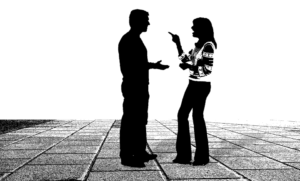 During election years, pent-up frustrations, simmering animosities, and the toxic legacy of countless hours of hate talk radio erupt from the seething volcano of the American public. Injustice left festering explodes into anger and hatred. Defensive arrogance and condescension drips down the pyramid of privilege.
During election years, pent-up frustrations, simmering animosities, and the toxic legacy of countless hours of hate talk radio erupt from the seething volcano of the American public. Injustice left festering explodes into anger and hatred. Defensive arrogance and condescension drips down the pyramid of privilege.
What should – and perhaps someday could – be a time of remarkable civic discourse, truth-telling, education, and public dialogue devolves into political shouting matches that leave millions of American citizens feeling bruised and abused, belligerent waiting for the next go-round of the elections to take vengeance on each other.
I am a member of the last generation of American children who received civics education in our public schools. Budget constraints and curriculum cuts have stripped our youth of access to knowledge not just about the three branches of government, the constitution, the electoral process, but also about the broader context of democracy, historically and worldwide. In the void of education, we learn from observing the current political climate – a circus of extreme wealth, party politics, manipulations, fraud, deceit, personality candidates, disempowerment of citizens, corporate sponsorship, name-calling, shaming, personal attacks, and the endless stream of broken campaign promises.
While this is, unfortunately, an accurate representation of how our dysfunctional political system currently operates, it also fails to articulate or embody the values of true democracy or of a democratic society.
As a child in a rural Maine public school, I learned about the nuanced discussions of democracy from the ancient Greeks through the founding fathers. I learned the shortcomings, foibles and follies of both the individual characters and the governing systems they produced. My memory of my civics courses evoke images of the white-clad suffragettes with sewn banners and African-Americans organizing nonviolent action that led toward civil rights and the Voting Rights Act. And, oddly, I have a persistent memory of a French woman in a cafe holding a lively discussion about politics and elections.
Where did this come from? One afternoon, a civics teacher invoked this semi-mythic figure to stimulate the half-glazed expressions in the classrooms. Politics should not be vitriolic or boring, our teacher told us, we should enjoy political discussions and consider them an essential part of the culture of a democratic society. By lunch, most of my classmates went back to talking about soccer or pop songs, but the lesson stuck with me.
This election cycle, as my fellow Americans froth at the mouth, I find this memory returning as I interact online and in person. Why is it so hard for us to have a passionate – not scornful or vituperative – conversation about politics? Has respectful discourse, like civics, fallen by the wayside of American education? Are we trained only in argument, attack, humiliation, screeching, vilifying, fear mongering, and other forms of verbal abuse?
This is unfortunate and dangerous. Discourse is the foundation of democracy. Even within the context of a representative republic, the ability to have a respectful, engaged, and informed conversation about politics – in the post office, our homes, on the media, with friends, family, or with total strangers – is essential for a society that prizes the ideals of liberty and freedom.
If we are not free to converse without being verbally assaulted, insulted, and screamed at, what does that say about the content of our characters? Why should any of us believe that shaming another citizen for their political choices is an effective approach to building the kind of political engagements and civic interest that greases the wheel of functional political process? Is it really so hard to engage in the practices of being curious about our differences, asking questions, listening, and responding in a sane and civil manner?
We can do better than the obnoxious and insulting manners we are currently displaying during this election cycle. These behaviors are beneath the dignity of a nation that claims to be a democracy and professes to have operated as one for 240 years.
If there is one political action every American should take between now and November, it is to lift our heads with greater dignity and treat our fellow Americans with respect. Regardless of others, our own self-respect should demand such action. We can engage in functional civic dialogue. There is no need to wait for the “leadership” of politicians, parties, pundits or press. In our own lives and interactions, we can discuss politics in a way that uplifts the dignity of all.
___________
A uthor/Activist Rivera Sun, syndicated by PeaceVoice, is the author of The Dandelion Insurrection, Billionaire Buddha and Steam Drills, Treadmills, and Shooting Stars, the cohost of Love (and Revolution) Radio, and the cofounder of the Love-In-Action Network. She is a trainer and social media coordinator for Campaign Nonviolence and Pace e Bene. Sun attended the James Lawson Institute on Strategic Nonviolent Resistance in 2014 and her essays on social justice movements appear in Truthout and Popular Resistance. www.riverasun.com
uthor/Activist Rivera Sun, syndicated by PeaceVoice, is the author of The Dandelion Insurrection, Billionaire Buddha and Steam Drills, Treadmills, and Shooting Stars, the cohost of Love (and Revolution) Radio, and the cofounder of the Love-In-Action Network. She is a trainer and social media coordinator for Campaign Nonviolence and Pace e Bene. Sun attended the James Lawson Institute on Strategic Nonviolent Resistance in 2014 and her essays on social justice movements appear in Truthout and Popular Resistance. www.riverasun.com
August 1, 2016
We Can’t Bomb Our Way to Better Schools
 “A nation that continues year after year to spend more money on military defense than on programs of social uplift is approaching spiritual death.” ~ Dr. King
“A nation that continues year after year to spend more money on military defense than on programs of social uplift is approaching spiritual death.” ~ Dr. King
From the left and the right, policy proposals are flying fast and furious. It is an election year, after all. But one topic is completely off the agenda from both sides of the party line: decreasing military spending.
Today’s political candidates are universally unwilling to discuss the military budget, overseas aggression, nuclear weapons, militarism, or imperialism – except to recommend more of it.
The problem is, we can’t bomb our way into better schools.
Year after year, we continue to pour our tax dollars into the war budget at the expense of other social programs. And, even as we overfund the military contractors, we also fail to care for our veterans and renege on our recruitment promises of education and jobs for the youth. Neither of the two major-party presidential candidates will discuss ending the endless war, bringing our troops home, or investing in improving the infrastructure, education, and opportunities here at home.
Those who study the rise and fall of empires know that the obsession with military expansion, and the pouring of a nation’s resources into militarism at the expense of other programs leads to collapse. The fall of many powerful empires throughout human history has been preceded by such a cycle. Regardless of one’s views on whether or not the United States should be pursuing the goal of imperialism, the obvious truth is that we are, in fact, a heavily militarized empire, with five colonial territories, andnearly 700 military bases in countries around the world.
We’re operating on increasingly shaky ground. As we head into the elections, where are the candidates who will frankly acknowledge this danger? Who will commit to investing in our youth, our communities, and our people? Will we continue to obsessively and aggressively try to demonstrate our greatness through military might or will we find ways to humbly and compassionately strive for basic goodness – not even greatness – in the way we treat one another here at home?
We may be modern people with smartphones, airplanes, and entrenched beliefs in our political divisions, but at the end of the day, human values haven’t changed much. We’re still hoping and longing for the same things. We all want our kids to be healthy. We want our schools to be engaging and empowering. We want our communities to be safe. We want to have enough. We don’t want to be hungry or homeless. We don’t want bombs dropping on our heads. We want meaningful opportunities for our young people (and ourselves). We want a world for our great, great grandchildren.
The question is: how do we get those things? Although the policies, platforms, and proposals abound, one thing is clear: continuing to overfund the military at the expense of programs of social uplift is not going to improve the situation of the average American. As Dr. King adroitly pointed out so many years ago, we are approaching spiritual death by continuing on this path. At the end of our endless wars, what are we defending? As we gut our schools, incarcerate our populace, over-police our poor communities, let roads and infrastructure crumble, what exactly are we sending our sons and daughters overseas to protect? We cannot bomb our way into better schools. Instead, we must beat the swords of our bombers into plowshares, study war no more, and rebuild the spiritual, moral, and cultural integrity of our nation.
_____________
A uthor/Activist Rivera Sun, syndicated by PeaceVoice, is the author of The Dandelion Insurrection, Billionaire Buddha and Steam Drills, Treadmills, and Shooting Stars, the cohost of Love (and Revolution) Radio, and the cofounder of the Love-In-Action Network. She is a trainer and social media coordinator for Campaign Nonviolence and Pace e Bene. Sun attended the James Lawson Institute on Strategic Nonviolent Resistance in 2014 and her essays on social justice movements appear in Truthout and Popular Resistance. www.riverasun.com
uthor/Activist Rivera Sun, syndicated by PeaceVoice, is the author of The Dandelion Insurrection, Billionaire Buddha and Steam Drills, Treadmills, and Shooting Stars, the cohost of Love (and Revolution) Radio, and the cofounder of the Love-In-Action Network. She is a trainer and social media coordinator for Campaign Nonviolence and Pace e Bene. Sun attended the James Lawson Institute on Strategic Nonviolent Resistance in 2014 and her essays on social justice movements appear in Truthout and Popular Resistance. www.riverasun.com
July 31, 2016
You the Great!

This photo comes from the Campaign Nonviolence Week of Actions in 2014, when a solo demonstrator engaged her community, one person at a time.
“A voice of one is better than the voice of none.” This sentence sums up much of my approach to speaking truth, demonstrating, and showing up. I’m not waiting for the crowd, for the great leader, or for the glorious revolution. I want to speak up, show up, stand up. I don’t care if I’m the only person there. I’m there.
To often, we wait for someone else to take action before finding our own courage. Why? Who exactly are we waiting for? The new Jesus-Gandhi-King isn’t some politician – all three of those figures were decidedly NOT running for political office – the new hero is us, all of us, all together. It’s a hero with a billion faces. And guess what? No one’s coming to save you. You aren’t a princess in a tower. You’re the gosh-darned plucky under-dog ordinary, extraordinary hero.
The Chinese I-ching has a great character in the mythic backstory behind the hexagrams. He’s called Yu the Great. It’s fabulous, because the homonym between English and Chinese (which is only significant in my poetic world of synchronicity) makes that You the Great. In the myths, Yu is a hero because he rallied the people to collective action, and together they drained the marshes and drove out the demons and planted the fields. His story is one of abandoning the path of lonely heroism – the path his father chose and found only failure and death along.
So You the Great, we the great, are the heroes of our time. Together, we can make the changes happen. But, we can’t wait for anyone else. We have to decide to be leaderful, to show up, to take action, to invite others to join us instead of waiting like wallflowers to be invited to the party. We’ve got to throw the street party, the demonstration, the movement. We’re not The Great Leader, we’re one of the many people who are learning to stand on our own two feet, to think for ourselves, to do what is right not because it’s in vogue, but because we know it’s right.
Welcome to the adventure, my friends.
________
Remember … taking a public stand for peace and active nonviolence always has an effect. It breaks the complicity of silence. It brings the message of change to the eyes of the public. This September 18-25th, be sure to join the Campaign NonviolenceWeek of Actions by holding a sign in a public space with a message about building a culture of peace and active nonviolence, free from war, poverty,racism, climate crisis, and the epidemic of violence. All actions, small or large, are counted in the Week of Actions. Let us know you’ll take action with us!http://www.paceebene.org/programs/campaign-nonviolence/campaign-nonviolence-week-of-actions/
This photo comes from the Campaign Nonviolence Week of Actions in 2014, when a solo demonstrator engaged her community in profound discussions, one person at a time.
July 30, 2016
Who Will Speak for the Voiceless?
 The forest sways in ripples of green. Wind sends the dappled sunlight sparkling through the branches. These are the things we forget in the heat of the political season. There are few politicians who will speak on behalf of all people . . . and even fewer who will speak for the beings that comprise the other 99 percent of the planet and are essential for human existence.
The forest sways in ripples of green. Wind sends the dappled sunlight sparkling through the branches. These are the things we forget in the heat of the political season. There are few politicians who will speak on behalf of all people . . . and even fewer who will speak for the beings that comprise the other 99 percent of the planet and are essential for human existence.
Sitting in the forests of rural Maine last week, I stared for hours at the swaying walls of green. Having lived too long in dry places, in landscapes of dust and drought, on concrete and asphalt flatlands, in the stench of exhaust, I had nearly forgotten the beauty of a forest deep in the verdant sigh of summer. As I sit here in a tucked-away section of woods between small farms and fishing coves, the forests return to prominence in my thoughts, replenishing . . . yet troubling.
More than half of the population of the United States has become urbanized. We live under the canopy of skyscrapers. Asphalt is the new green. Climate change is measured by increased air conditioning bills. For many citizens and public officials, nature is an abstract idea hanging like a wall calendar in our minds.
Even among the rural populace, many live in mono-cropped landscapes amidst thousands of acres of genetically modified soy and corn. How many rural voters believe the misinformation on screens rather than their eyes and lifetimes of experiences? Climate denialism still spouts from the mouths of many. The disconnection is severe and dangerous.
For most Americans, the holocaust of mass species extinction has already occurred within their neighborhood. Within our human-dominated landscapes, most of the native and wild species have long since been crowded out. The death of our fellow species is abstract because they died to our “world” decades ago. Why would an inner-city child mourn the death of a butterfly she’s never seen? Who in the suburbs realizes how sterile and deathly still their yards have already become?
How many more election cycles do we get?
The answer is not many. In November, millions of Americans will go to the polls, line up on concrete, wait in office buildings, and then tap screens of choices for political candidates. They will vote for the lesser evil, to make America great again, to put a woman in the White House, or in vain hopes of ousting corporatocracy, oligarchy, or big government out of power. They will vote on slogans, circuses, email scandals and celebrity hat tricks. They will vote on what the pundits tell them.
And all the while, the clock is ticking. Another day passes. The sun is touching the tips of the green trees across the meadow. The planet is heating. Where I live, the mountains are burning. The twisted pines of the desert forests are yellowing with disease and bug infestations. The rivers are shrinking. We normalize these things, attuning to the increasing heat levels, compensating for the lack of rain and humidity by drawing up more water from underground aquifers. A few years ago, a catastrophic forest fire nearly burned Los Alamos National Laboratory – and tons of radioactive waste and stored plutonium – into ash. That record-breaking fire was turned aside just miles from Los Alamos. It raged so hotly that the earth literally melted. Sections of the burn area still look like black moonscapes, even years later.
Who mourns these forests? Who remembers them? Who invokes these swaying giants of trees as they ride the subway? Who consults these leafy communities of being as they make public policies that affect our world? We have largely forgotten these things and our responsibility to them. Humans gather in windowless rooms illuminated by burning kilowatts of fossil fuels or deadly nuclear fission, amplifying a few voices to crowds of other human beings, declaring why this candidate or that should become the next president.
Outside, the trees outnumber humans. Voiceless, unable to travel to conventions or vote, without any hope of political representation, the forests, the Earth, and our fragile, interdependent existence have been left out of democracy. The forests transform the exhaust of our words, breath, cars, and factories into the oxygen we require for existence. And yet, who speaks for them from the podium? Who honors the gift of life the forests bring? Who acknowledges the heavy burden of responsibility we are faced with now?
I am sitting in Maine, in the forest, remembering the things that we seem to have forgotten as we traverse concrete and drought-cracked landscapes, dusty and grimy. My breath is slow and saddened as I watch the tidal sway of the trees rippling in the wind. The sun sets over the branches, shadows lengthen. No easy answers come. Election Day draws closer.
_____________
A uthor/Activist Rivera Sun, syndicated by PeaceVoice, is the author of The Dandelion Insurrection, Billionaire Buddha and Steam Drills, Treadmills, and Shooting Stars, the cohost of Love (and Revolution) Radio, and the cofounder of the Love-In-Action Network. She is a trainer and social media coordinator for Campaign Nonviolence and Pace e Bene. Sun attended the James Lawson Institute on Strategic Nonviolent Resistance in 2014 and her essays on social justice movements appear in Truthout and Popular Resistance. www.riverasun.com
uthor/Activist Rivera Sun, syndicated by PeaceVoice, is the author of The Dandelion Insurrection, Billionaire Buddha and Steam Drills, Treadmills, and Shooting Stars, the cohost of Love (and Revolution) Radio, and the cofounder of the Love-In-Action Network. She is a trainer and social media coordinator for Campaign Nonviolence and Pace e Bene. Sun attended the James Lawson Institute on Strategic Nonviolent Resistance in 2014 and her essays on social justice movements appear in Truthout and Popular Resistance. www.riverasun.com
Vote Fear and Fear Wins
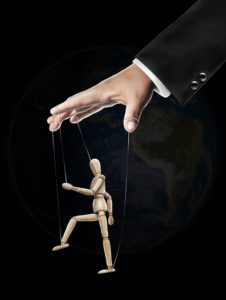
CCO Public Domain Image
Watching the electoral cycle this year is like watching an old movie from a warped film reel with the sound out of sync. The puppet figures of politicians go through the meaningless gestures. The familiar slogans and catch phrases groan from twisted mouths, distorted and odd. A maniacal fervor pulses in the expressions of the assembled.
Fear, not courage or vision, is the driving factor behind this year’s electoral cycle. Be afraid, be very afraid, is the subtext of the speeches on both the left and right. The notions of safety and security pop up frequently. Our veterans and troops are invoked. The threat of the faceless, caricatured “enemy” lurks on the edges of the speeches. The need for a heavy militarization in all corners of the globe is never questioned, neither by the left nor by the right.
With our chests constricted with anxiety, hearts hammering with worry, minds clouded with fear of the other – Trump, Clinton, terrorists, racists, xenophobia, free markets, communists, police state, the climate crisis, economic collapse – the politicians have us in their hands. Our eyes narrow at each other. We build mental walls left and right. We head to the polls, determined to beat the enemy with our votes.
At the end of the day, we lose.
Every election cycle, the people lose. We lose our respect. We lose our dignity. We lose our civility toward one another. We lose our critical thinking skills. We lose our heads. We lose our hearts. We don’t win, we just lose.
President Franklin Roosevelt said, “The only thing we have to fear is fear itself.” The rampant fear mongering of both parties, the media, the pundits, and the believing populace sows the seeds of hatred, acrimony, short-sightedness, bigotry, intolerance, violence, and conflict.
We have serious issues to deal with as Americans. On every level of our society, we face challenges that require the engagement of a mature, active, and committed citizenry. The shadow of nuclear war looms once again. The threat of climate catastrophe races toward us. Economic upheaval is on our doorstep. Violence is breaking out on our streets. No amount of scapegoating, finger pointing or blaming will help us resolve these issues. Divisions in viewpoints, knowledge, information sources and perspectives have created a deeply troubling state of disunion, one in which civic process, discourse, conflict resolution and problem-solving flounder.
Fear is a tactic used by the despotic or the power-lusting to manipulate and control us. It is the responsibility of all citizens, left and right, to challenge it vigorously. We must question those who tell us to fear. We must confront it within our own hearts. Otherwise, on Election Day, we will find that only our fears will win.
_____________
A uthor/Activist Rivera Sun, syndicated by PeaceVoice, is the author of The Dandelion Insurrection, Billionaire Buddha and Steam Drills, Treadmills, and Shooting Stars, the cohost of Love (and Revolution) Radio, and the cofounder of the Love-In-Action Network. She is a trainer and social media coordinator for Campaign Nonviolence and Pace e Bene. Sun attended the James Lawson Institute on Strategic Nonviolent Resistance in 2014 and her essays on social justice movements appear in Truthout and Popular Resistance. www.riverasun.com
uthor/Activist Rivera Sun, syndicated by PeaceVoice, is the author of The Dandelion Insurrection, Billionaire Buddha and Steam Drills, Treadmills, and Shooting Stars, the cohost of Love (and Revolution) Radio, and the cofounder of the Love-In-Action Network. She is a trainer and social media coordinator for Campaign Nonviolence and Pace e Bene. Sun attended the James Lawson Institute on Strategic Nonviolent Resistance in 2014 and her essays on social justice movements appear in Truthout and Popular Resistance. www.riverasun.com
June 28, 2016
The Nonviolent History of American Independence
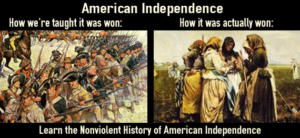 Independence Day is commemorated with fireworks and flag-waving, gun salutes and military parades . . . however, one of our nation’s founding fathers, John Adams, wrote, “A history of military operations . . . is not a history of the American Revolution.”
Independence Day is commemorated with fireworks and flag-waving, gun salutes and military parades . . . however, one of our nation’s founding fathers, John Adams, wrote, “A history of military operations . . . is not a history of the American Revolution.”
Often minimized in our history books, the tactics of nonviolent action played a powerful role in achieving American Independence from British rule. Benjamin Naimark-Rowse wrote, “the lesson we learn of a democracy forged in the crucible of revolutionary war tends to ignore how a decade of nonviolent resistance before the shot-heard-round-the-world shaped the founding of the United States, strengthened our sense of political identity, and laid the foundation of our democracy.”
One hundred-fifty years before Gandhi, the American colonists employed many of the same nonviolent actions the Indian Self-Rule Movement would later use to free themselves from the same empire – Great Britain. The boycotting of British goods (tea, cloth, and other imported items) significantly undermined British profits from the colonies. Noncooperation with unjust laws eroded British authority as the colonists refused to comply with laws that restricted assembly and speech, allowed the quartering of soldiers in colonists’ homes, and imposed curfews. Non-payment of taxes would prove to be a landmark issue for the independence movement. The development of parallel governments and legal structures strengthened the self-rule and self-reliance of the colonists and grew local political control that would ultimately prove strong enough to replace British governance of the colonies. Acts of protest and persuasion, petitions, pamphlets, rallies, marches, denouncements, legal and illegal publications of articles, and disruption of British meetings and legal proceedings were also employed.
Some of the most powerful boycotts in nonviolent history occurred in the New England colonies against the British Crown. Though the term boycott would not emerge for another hundred years until the Irish coined it during tenant and land struggles, what the colonists called “nonimportation programs” dropped British revenue in New England by 88 percent between 1774 and 1775. In the Carolinas, colonists deprived the Crown of 98.7 percent of import revenue. Moreover, in Virginia and Maryland, the rate reached an impressive 99.6 percent participation.
Resistance to the Stamp Act of 1764 thru 1775 dropped revenues 95 percent below what was expected. The British could not even pay for the cost of enforcing the Stamp Act throughout the colonies, and it was repealed in 1766. Newspapers published without paying the Stamp Tax used noms de plume to avoid reprisal. Courts closed because lawyers and judges refused to pay the Stamp Act for the printing of court documents. Shipping permits were supposed to be stamped, and, since merchants and shippers refused to pay the tax, ports closed, and even official documents were not delivered! Merchants of New York, Boston, and Philadelphia pledged a nonimportation pact until the Stamp Act was repealed. Six months later (at a time when crossing the Atlantic by sail took at least six weeks, and sometimes as long as three months), the Crown repealed the Stamp Act under pressure from its own panicked merchants.
In a campaign that is strikingly familiar to Gandhi’s spinning campaign, the American boycott of imported British cloth held spin-ins, whereby young women gathered in large groups to spin homespun yarn for weaving cloth. Colonists even stopped wearing the traditional funeral black (which mirrored English style) in protest of Great Britain. Women played significant roles in all the nonimportation programs, especially the resistance to the notorious Tea Act. While everyone remembers the Boston Tea Party’s dumping of tea into the Boston Harbor, few Americans have heard about how Susan Boudinot. She was the nine-year-old daughter of a New Jersey patriot, who, when handed a cup of tea while visiting the governor, curtsied, raised the cup to her lips, and then tossed the tea out the window.
These are just some of the many nonviolent actions engaged in by Americans in their struggle for independence. Some scholars even go so far as to call the Revolutionary War, the “War of Reclamation,” for the revolution had already been won in the hearts, minds, homes, and practices of the people by the time the British Crown sought to reclaim the independent and self-governing colonies. This Independence Day, tell the stories of the role nonviolent action played in establishing the United States. Perhaps by next year, we will be participating in re-enactments of spin-ins, holding mock funerals for Lady Liberty, and engaging in boycotts of imported goods to commemorate how American Independence was actually won.
_____________________
A uthor/Activist Rivera Sun, syndicated by PeaceVoice, is the author of The Dandelion Insurrection, Billionaire Buddha and Steam Drills, Treadmills, and Shooting Stars, the cohost of Love (and Revolution) Radio, and the cofounder of the Love-In-Action Network. She is a trainer and social media coordinator for Campaign Nonviolence and Pace e Bene. Sun attended the James Lawson Institute on Strategic Nonviolent Resistance in 2014 and her essays on social justice movements appear in Truthout and Popular Resistance. www.riverasun.com
uthor/Activist Rivera Sun, syndicated by PeaceVoice, is the author of The Dandelion Insurrection, Billionaire Buddha and Steam Drills, Treadmills, and Shooting Stars, the cohost of Love (and Revolution) Radio, and the cofounder of the Love-In-Action Network. She is a trainer and social media coordinator for Campaign Nonviolence and Pace e Bene. Sun attended the James Lawson Institute on Strategic Nonviolent Resistance in 2014 and her essays on social justice movements appear in Truthout and Popular Resistance. www.riverasun.com
June 27, 2016
Got Strategy? It takes more than a single action to make a movement.
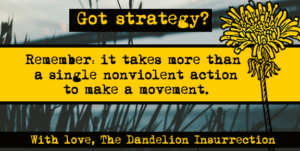 It takes more than a single action to make a movement. And, who’s to say YOU won’t launch, organize, and carry out a series of effective nonviolent actions that build into a set of powerful campaigns that form the arc of a world-changing movement? Find a couple friends, dust off your strategic thinking caps, and start to discuss and plan how to make change in a deliberate way.
It takes more than a single action to make a movement. And, who’s to say YOU won’t launch, organize, and carry out a series of effective nonviolent actions that build into a set of powerful campaigns that form the arc of a world-changing movement? Find a couple friends, dust off your strategic thinking caps, and start to discuss and plan how to make change in a deliberate way.
Many of us are stuck in the same old ruts of showing up at one protest after another, wondering if what we’re doing makes any difference. We look to heads of organizations, hoping they’ll come up with a plan of action that makes sense. Too often, we see the same worn-out “call your senators” routine, or the usual tactics of protesting. We forget that movements are made up of the stepping-stones of campaigns, which use a whole series of actions to achieve their goals.
As Robert Swan said, “The greatest danger to our planet is the belief that someone else will save it.” This is true not only for the planet, but also for our communities, our families, and all of the social justice issues we face. With hindsight, we look at our heroes of nonviolent history and they loom like giants in our minds. Little do we know that M.K. Gandhi was once an awkward and shy lawyer who trembled at the thought of public speaking. He took a step, and then another, followed by a thousand more, and along that path a movement was built. We can also take the first step in our own situations.
Sit down and think about the problem or injustice you face. What keeps it in place? What supports its existence? Who are the people who lend their time, skills, hands, work, labor, experience, power, clout, and brains to keeping that injustice going? How might you use nonviolent action to remove the support of your friends, neighbors, community, coworkers from the injustice? How might you use protest and persuasion and outreach to connect with wider circles of people who perpetuate the problem? How might you interrupt and intervene in the business-as-usual attitude of the injustice that you face?
These are the questions we can all ask as we begin to address the problems we face with strategy and attention. Take heart! Across the country and around the world, thousands of ordinary, extraordinary people like you are sitting down in kitchens, living rooms, coffee shops, backyards, pool halls, common rooms, and churches to work on these same questions. The nonviolent movements for change are growing in size, strength, and strategic wisdom. You are a part of this change.
_____________________
A uthor/Activist Rivera Sun, syndicated by PeaceVoice, is the author of The Dandelion Insurrection, Billionaire Buddha and Steam Drills, Treadmills, and Shooting Stars, the cohost of Love (and Revolution) Radio, and the cofounder of the Love-In-Action Network. She is a trainer and social media coordinator for Campaign Nonviolence and Pace e Bene. Sun attended the James Lawson Institute on Strategic Nonviolent Resistance in 2014 and her essays on social justice movements appear in Truthout and Popular Resistance. www.riverasun.com
uthor/Activist Rivera Sun, syndicated by PeaceVoice, is the author of The Dandelion Insurrection, Billionaire Buddha and Steam Drills, Treadmills, and Shooting Stars, the cohost of Love (and Revolution) Radio, and the cofounder of the Love-In-Action Network. She is a trainer and social media coordinator for Campaign Nonviolence and Pace e Bene. Sun attended the James Lawson Institute on Strategic Nonviolent Resistance in 2014 and her essays on social justice movements appear in Truthout and Popular Resistance. www.riverasun.com
Got Strategy? Acts of Intervention
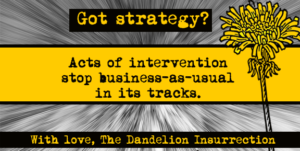 There are over two hundred methods of nonviolent action. Gene Sharp categorized them into three major groups: acts of protest and persuasion, acts of noncooperation, and acts of intervention.
There are over two hundred methods of nonviolent action. Gene Sharp categorized them into three major groups: acts of protest and persuasion, acts of noncooperation, and acts of intervention.
Acts of intervention literally interrupt business-as-usual and disrupt the functioning of systems. Usually (though not always) these types of nonviolent actions involve people physically putting their bodies on the line. These types of actions include blockades, occupations, sit-ins, mill-ins, over-loading of facilities and/or administrative offices, guerrilla theater that disrupts meetings or normal procedures, obstructions, nonviolent raids and invasions, establishing new social patterns, stay-in strikes, defiance of blockades, establishing parallel or alternative governments or institutions, whistle-blowing, and more.
Along with acts of noncooperation, these types of nonviolent action can be quite powerful in making change. They often re-arrange normal systems to such a degree that your opposition has to change their stance. Sometimes, this means conceding to the demands of the movement. However, other times, the opposition will respond with increased repression (violent, legal, monetary, social or political, or other). Be aware of this as you plan your actions. Does your movement have the strength to maintain the action and withstand repression? What might your movement need to do in preparation?
_______________________
What is The Dandelion Insurrection? It’s a novel about a nonviolent movement for change in “a time that looms around the corner of today”, set in a (slightly) fictionalized United States to oust a not-so-hidden corporate dictatorship. Read the book, live the story.
You can find the book here: https://www.amazon.com/Dandelion-Insurrection-love-revolution/dp/098481325X
Not a fan of mega-corporations? You can also get a copy here: http://www.riverasun.com/online-store/the-dandelion-insurrection/
_____________________
A uthor/Activist Rivera Sun, syndicated by PeaceVoice, is the author of The Dandelion Insurrection, Billionaire Buddha and Steam Drills, Treadmills, and Shooting Stars, the cohost of Love (and Revolution) Radio, and the cofounder of the Love-In-Action Network. She is a trainer and social media coordinator for Campaign Nonviolence and Pace e Bene. Sun attended the James Lawson Institute on Strategic Nonviolent Resistance in 2014 and her essays on social justice movements appear in Truthout and Popular Resistance. www.riverasun.com
uthor/Activist Rivera Sun, syndicated by PeaceVoice, is the author of The Dandelion Insurrection, Billionaire Buddha and Steam Drills, Treadmills, and Shooting Stars, the cohost of Love (and Revolution) Radio, and the cofounder of the Love-In-Action Network. She is a trainer and social media coordinator for Campaign Nonviolence and Pace e Bene. Sun attended the James Lawson Institute on Strategic Nonviolent Resistance in 2014 and her essays on social justice movements appear in Truthout and Popular Resistance. www.riverasun.com
Got Strategy? How About a Grand Strategy?
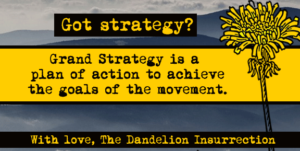 Grand Strategy is a plan of action to achieve the major or overall goals of your movement. It’s different than campaign-level strategy, or strategy for specific nonviolent actions (which should include dates, times, location, weather, people, contingency plans, signage, etc. and so forth.) Grand Strategy is a broad view of the arc of the movement. It might be as simple as a couple of sentences, such as, “remove the dictator from power through mass noncooperation when he steals the next election” or “Use nonviolent actions such as strikes and boycotts to non-cooperate with Corporation X until living wages are assured”.
Grand Strategy is a plan of action to achieve the major or overall goals of your movement. It’s different than campaign-level strategy, or strategy for specific nonviolent actions (which should include dates, times, location, weather, people, contingency plans, signage, etc. and so forth.) Grand Strategy is a broad view of the arc of the movement. It might be as simple as a couple of sentences, such as, “remove the dictator from power through mass noncooperation when he steals the next election” or “Use nonviolent actions such as strikes and boycotts to non-cooperate with Corporation X until living wages are assured”.
Why is this important? Crafting a grand strategy can help your movement come to consensus about the goals and about the means of achieving those goals. It helps to keep the focus of the movement clear. For example, a grand strategy that says, “Change the government from a dictatorship to a democracy using a series of nonviolent campaigns to remove the pillars of support and society away from cooperation with the regime” is quite different than, “change the government from a dictatorship to an oligarchy using guns and militia to murder the opposition groups.”
Think about the movements you’re a part of … what does their grand strategy appear to be? Do they have one? Do you agree with it? If not, how might you approach a grand strategy for your movement? These are important questions to ask yourself and your movement colleagues.
___________________________
Did the Dandelion Insurrection novel have a grand strategy? You bet! It’s on page 49. How else could the movement have organized a leader-full structure that could self-organize effectively without knowing their shared goals and the means of achieving them!? Even fictional movements like The Dandelion Insurrection benefit from having a grand strategy to help them oust a not-so-hidden corporate dictatorship. 
Got Strategy? Initiating vs. Reacting and Taking Back the Escalation Curve
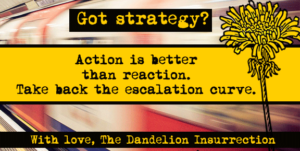 Too often, our movements find themselves reacting instead of initiating the dynamic events of the struggle. Take back the escalation curve by engaging in strategic thinking, foresight, and planning. Don’t wait for your opposition to attack you . . . organize and mobilize in advance of the crisis.
Too often, our movements find themselves reacting instead of initiating the dynamic events of the struggle. Take back the escalation curve by engaging in strategic thinking, foresight, and planning. Don’t wait for your opposition to attack you . . . organize and mobilize in advance of the crisis.
Easier said than done, right? We often feel assaulted and barraged by the flurry of injustices that strike our communities. It’s common to have to run around and put out fires. Consider creating a team to focus on strategic planning while another team organizes to stop the worst of the damages. This is common sense and sound strategic theory. If the military uses it, why can’t our movements?
We need to find ways to give at least some people in our community permission and support to do long range thinking, planning, and envisioning. Even if it seems nearly impossible, see if you can find a way. In 1959, Dr. Martin Luther King, Jr. and Coretta Scott King traveled to India for a month to study Gandhian nonviolence. Remember, this is after the Montgomery Bus Boycott that propelled Dr. King into the spotlight, in the middle of the sit-in campaigns to desegregate the downtown lunch counters and stores. It’s also right before Albany, GA, the Freedom Rides, and prior to the Selma and Birmingham, AL campaigns, the Mississippi Freedom Summer and Voting Rights campaigns, and the March on Washington.
Taking back the escalation curve and timeline of a struggle requires that we think, strategize, and plan in advance of the opposition. It means that we initiate the campaigns, rather than wait to be attacked. It requires the energy to mobilize and to galvanize our movement into action. Is it easy? Never. Can it be done? Yes.
_____________________
A uthor/Activist Rivera Sun, syndicated by PeaceVoice, is the author of The Dandelion Insurrection, Billionaire Buddha and Steam Drills, Treadmills, and Shooting Stars, the cohost of Love (and Revolution) Radio, and the cofounder of the Love-In-Action Network. She is a trainer and social media coordinator for Campaign Nonviolence and Pace e Bene. Sun attended the James Lawson Institute on Strategic Nonviolent Resistance in 2014 and her essays on social justice movements appear in Truthout and Popular Resistance. www.riverasun.com
uthor/Activist Rivera Sun, syndicated by PeaceVoice, is the author of The Dandelion Insurrection, Billionaire Buddha and Steam Drills, Treadmills, and Shooting Stars, the cohost of Love (and Revolution) Radio, and the cofounder of the Love-In-Action Network. She is a trainer and social media coordinator for Campaign Nonviolence and Pace e Bene. Sun attended the James Lawson Institute on Strategic Nonviolent Resistance in 2014 and her essays on social justice movements appear in Truthout and Popular Resistance. www.riverasun.com
From the Desk of Rivera Sun
- Rivera Sun's profile
- 161 followers



